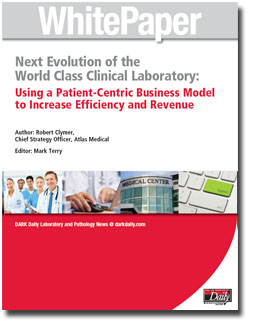Healthcare’s coming shift from fee-for-service to value-based reimbursement creates both a crisis and an opportunity for clinical laboratories and pathology groups.
With the era of fee-for-service medicine under siege, every clinical laboratory and anatomic pathology organization needs a strategy for getting paid, as new reimbursement models that support patient-centric care will make up a larger portion of lab revenues. Unfortunately, few real-world examples exist today to guide clinical laboratory executives as they develop these strategies.
Patient-centric medical care is an important goal for every healthcare provider. Patient-centered medical homes are enjoying strong growth and acceptance. Accountable care organizations (ACOs) are designed to serve the individual needs of each patient. Meanwhile, hospitals and physicians are getting better at measuring patient satisfaction because health plans are basing payment on these scores.
Timely Action by Clinical Laboratories and Pathology Groups
The challenge for every clinical laboratory organization is to understand how to evolve from a business model that is accession-centric or volume-centric to one that is patient-centric. One lab industry executive who engages with medical laboratories on this issue is Rob Atlas, CEO and President of Atlas Medical in Calabasas, California. He believes that few medical laboratories prepared to transition from volume-centric to patient-centric.
“It is unlikely that the current business model will allow medical laboratories to be successful in the future,” he noted. “That is why some early-adopter labs have started to deploy capabilities that are patient-centric. As the healthcare system shifts to a value-based, patient-centric approach, labs must find new ways to survive and thrive in this new paradigm.”
Two Challenges for Clinical Laboratories to Become Patient-Centric
Atlas sees two challenges for labs as they adopt patient-centric strategies. “First, a patient-centric approach means shifting from a laboratory business built on specimen volume to one that delivers more value—but this is value for which payers do not yet reimburse,” he noted.

One expert in medical laboratory informatics is Rob Atlas, CEO of Atlas Medical, which is based in Calabasas, California. Atlas believes that the time has come for clinical laboratories to begin the transition from being a volume-centric organization to being patient-centric. He is shown here speaking last May at the 18th Annual Executive War College on Laboratory and Pathology Management. This lab industry conference took place in New Orleans, Louisiana.
“Second, most clinical laboratories have yet to see an urgent demand from their customers to deliver more value in these new ways,” explained Atlas.” Nevertheless, the healthcare market is moving to patient-centric care. We believe that laboratories need to be prepared for this shift.
“Trends reshaping clinical care and the laboratory testing market are almost completely dependent on being patient-centric,” explained Atlas. “These include efforts to reduce duplicate or unnecessary testing, acceptance of test utilization management, consolidated lab test reporting, and greater attention to improving patient outcomes. Every initiative that laboratories need to do to support the continuum of care is focused on the patient,” he continued.
“In our strategic conversations with lab organizations nationwide, we see recognizing the need to add more value and, to accomplish this, they must become patient-centric,” said Atlas. “Many clinical laboratories today are developing data repositories to logically link all transactional and other information about a patient. These repositories allow physicians to see all relevant information, identify trends, and provide better care as a result, enabling labs to provide greater value to their customers, patients and payers.
Medical Laboratories Serving Hospitals and Physicians
“This is particularly true where a lab is serving hospitals and physicians that are involved in inpatient, outpatient, and outreach settings, explained Atlas. In these situations, clinicians need a complete medical laboratory test record for the patient, as the patient moves from the physician’s office to hospital and back again.
“Clinical labs that have longitudinal data on patients are supporting the continuum of care for the patient and are delivering greater value to their physician customers,” he noted. “This is much different than simply producing transactional medical laboratory results. In addition, adding lab test orders to the data repository enables the medical laboratory to prevent duplicate or unnecessary test ordering before a test is performed.”
“Labs also may consider what happens when a doctor orders a test for a recently hospitalized patient,” Atlas commented. “If a specific result comes back abnormal, the repository can: 1) be aware of a previous hospital admission; 2) check the discharge date and time; and, 3) notify the appropriate members of the care coordination team of the patient for potential readmission. By doing so, the clinical laboratory can improve patient care and minimize expense to those involved,” he added.
Clinical Laboratories Can Develop Patient-Centric Services
“These examples show that clinical laboratories have options and tools to develop patient-centric services and capabilities before new reimbursement models become prevalent within healthcare,” Atlas said. “Becoming patient-centric is necessary to transition from fee-for-service to fee-for-value based reimbursement. Most medical labs must adopt a patient-centric focus, and we believe now is the time to develop those capabilities. ”

Clinical laboratory executives and pathologists interested in learning more about how medical laboratories can become patient-centric can download this White Paper, “The Next Evolution of the World Class Clinical Laboratory: Using a Patient-Centric Business Model to Increase Efficiency and Revenue.” It was published recently by DarkDaily.com
One laboratory that is forging ahead with patient-centric services is Sonora Quest Laboratories, LLC, of Phoenix, Arizona. This is the joint venture laboratory company owned by Banner Health and Quest Diagnostics Incorporated (NYSE: DGX). At a time of increasing annual deductibles and higher co-pays for lab services, Sonora Quest has recognized it must become better at collecting past-due balances owed by patients when they present to provide laboratory specimen.
Sonora Quest Laboratories has added billing service representatives to its large patient service centers. These billing representatives are supported by a layer of informatics capabilities that includes technology from Atlas Medical. The goal is, at the time of service, to show patients exactly what they owe from prior clinical laboratory testing, mainly resulting from co-pays and deductibles.
In real time, the informatics solution provides the payment history specific to the patient’s health insurance coverage and reimbursement requirements. This informatics solution can immediately print an invoice for services provided to a patient who does not have insurance. Thus, prior to being served and while still present at the patient service center, this invoice makes it possible for an un-insured patient to pay for the clinical laboratory testing services ordered by the physician.
Equally important, Sonora Quest believes that—once this system is fully implemented—it will increase collections of overdue patient debt by several million dollars each year.
Report Available on Patient-Centric Lab Services
One resource for clinical laboratories and pathology groups that are interested in how to make the transition from volume-centric to patient-centric is Dark Daily’s newly-published White Paper. It is titled “The Next Evolution of the World Class Clinical Laboratory: Using a Patient-Centric Business Model to Increase Efficiency and Revenue,” and is available as a free download by clicking here.
In support of this educational White Paper on the patient-centric clinical laboratory, your Dark Daily editorial team is looking for clinical laboratories and pathology groups that have launched specific patient-centric services and would like to share their successes, along with the positive response by clinicians or health insurers. Please use this LINK to contact us and share your patient-centric service success stories.
—By Joseph Burns
Related Information:
Patient-centered Care is Associated with Decreased Health Care Utilization
Lab Medicine’s Role in Coordinated Care
The Meaning of Patient-Centric in Relationship to the LIS



